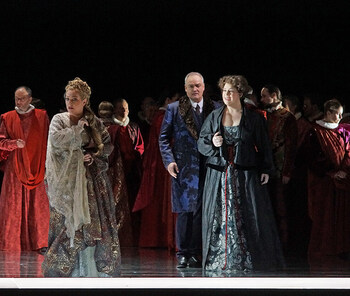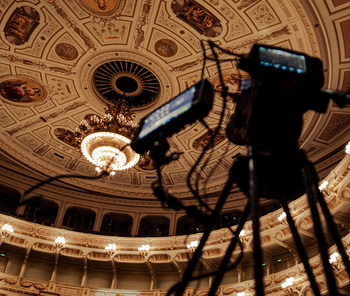Hector Berlioz
Premiere 29. June 2024
Performed in French with German and English supertitles
Dates
Info
- Starting Time: 7 pm
- One intermission
Venue: Semperoper Dresden
Free introductory talk- held in the Semper Opera House cellar 45 minutes before curtain-up
Info
- Starting Time: 6 pm
- One intermission
Venue: Semperoper Dresden
Free introductory talk- held in the Semper Opera House cellar 45 minutes before curtain-up
Piece-Info
In his early opera »Benvenuto Cellini«, which premiered in Paris in 1838, Hector Berlioz (1803-1869) produced an astonishing work of art centred around one of the most important artists of the 16th century. Although the opera sketches only three days in the colourful life of the Florentine sculptor, namely between Shrove Monday and Ash Wednesday in 1532, they are tumultuous enough: After several hours in the hustle and bustle of carnival celebrations in Rome, during which Cellini fatally stabs an enemy, the artist nevertheless enjoys sweet victory at the story’s end.
Hector Berlioz was known for his phenomenally differentiated use of the orchestra and its instruments. His many admirers included Richard Wagner. The richly varied score ranges from large-scale tableaux with rousing choral passages to uniquely orchestrated chamber scenes. In this way, Berlioz creates an unparalleled musical depiction of revelry at carnival time.
Act 1 – Carnival Monday
The papal treasurer Balducci is upset that the Pope's commission to cast a statue of Perseus has gone to the lazy Benvenuto Cellini and not to the pontiff’s personal sculptor Fieramosca. In addition, he is annoyed when he sees his daughter Teresa standing at the window and looking out curiously, despite his having repeatedly prohibited her from doing so. Summoned by the Pope, Balducci leaves the house, and Teresa once again stands at the window, listening to a jaunty Carnival song sung by Cellini and his friends. She vacillates between her feelings for Cellini, with whom she is secretly in love, and her obedience to her father, who wants to marry her to Fieramosca. Teresa receives Cellini in her room, but they are eavesdropped on by Fieramosca. Balducci returns soon afterward, and Cellini and Fieramosca are both forced to hide. While Cellini is able to escape, Balducci discovers the eavesdropper and boils with rage. Nevertheless, Fieramosca manages to get away.
Act 2 – Carnival Tuesday
Happily in love with Teresa, Cellini meets up with his friends and pupils in the tavern to carouse. When the proprietor asks him to pay the bill for the bacchanal, Cellini discovers that his wallet is empty. His apprentice Ascanio brings Cellini money from the Pope, who has granted an advance on the condition that Cellini complete the Perseus statue by the following day. Cellini gives his word, and the carousal is paid for. But Cellini and his friends are irritated that the papal treasurer has given such a small amount and hope to play a trick on Balducci. Their plan does not remain secret, however, since Fieramosca is also present. Wearing a prearranged mask, Cellini intends to meet Teresa and then abscond with her, but Fieramosca and his friend Pompeo mean to prevent this by turning up with the same mask.
In the midst of the hustle and bustle of the Carnival, Teresa, accompanied by her father, is plagued with guilt about the impending elopement, while Cellini and Ascanio are pleased that the fun and games are about to begin. At Cassandro's theater, known for its Commedia dell'arte plays, the papal treasurer is ruthlessly satirized. Outraged, he decides to take revenge on the authors. As Cellini and Ascanio approach Teresa, Fieramosca and Pompeo appear at the same time and in the same disguise. A bloody confrontation ensues during which Cellini stabs Pompeo. Cellini is initially held by the people, but then succeeds in escaping when a cannon shot heralds the end of the Carnival, giving rise to a great commotion. The people now accuse Fieramosca of being the murderer.
Act 3 – Ash Wednesday
Teresa talks to Ascanio about the previous day’s events and are happy to see Cellini return unscathed. But it has emerged that it is not Fieramosca who is the culprit, but Cellini. For this reason Cellini hopes to flee with Teresa, but without completing the Pope's commission. But no escape takes place, since Balducci confronts Cellini and assails his daughter with reproaches. Furious, he tells Teresa and Fieramosca, who has just hurried in, that they will be getting married today. Pope Clement VII witnesses the turmoil and orders someone else to complete the Perseus statue. But when Cellini threatens to shatter his model, the pontiff finally grants the sculptor a grace period, and even impunity. Cellini agrees, but he also demands Teresa's hand. And gets his wish. Immediately the artist sets to work. However, since there is not enough metal, he melts all the statues in his workshop. In the end, Cellini succeeds: the Perseus statue is cast, his murderous act is forgiven, he is permitted to take Teresa as his wife, and he is triumphantly celebrated by the people and clergy as an undisputed artist.
Gallery
Benvenuto Cellini










